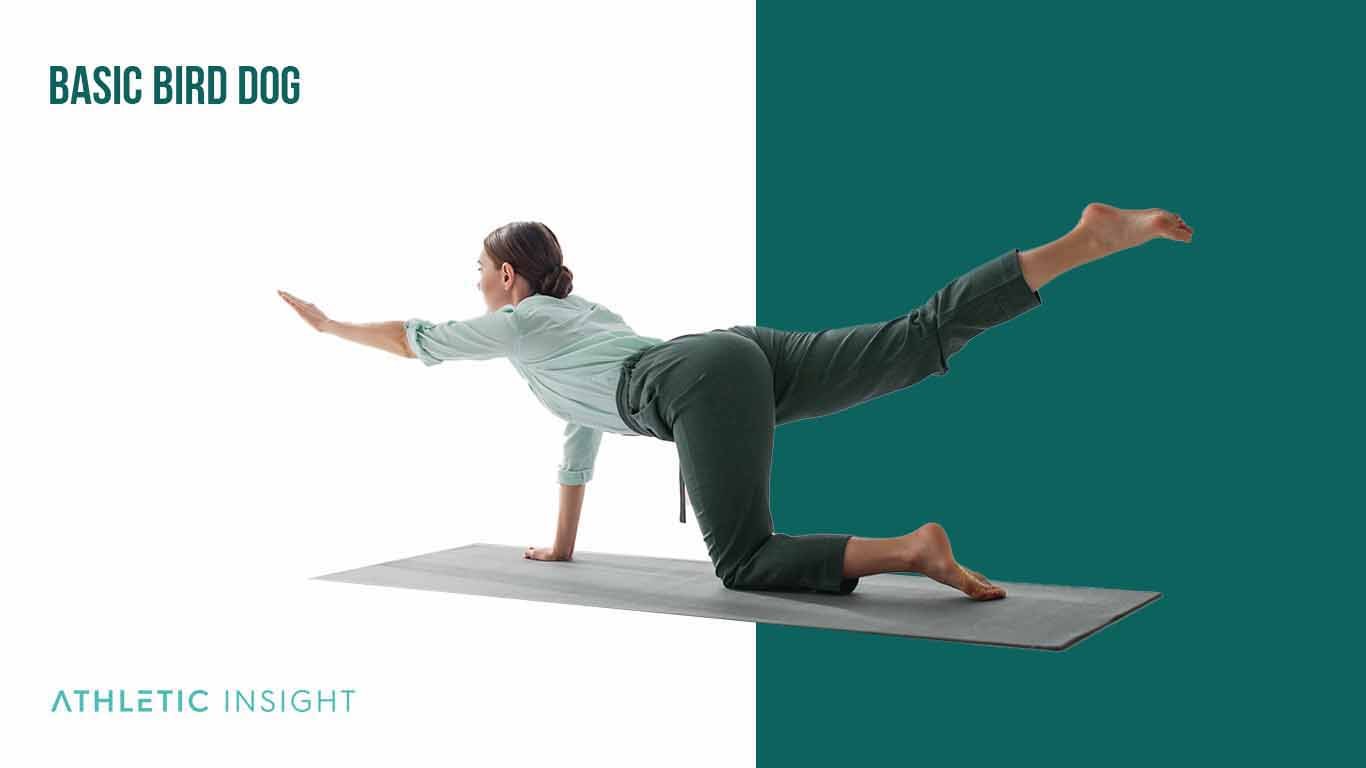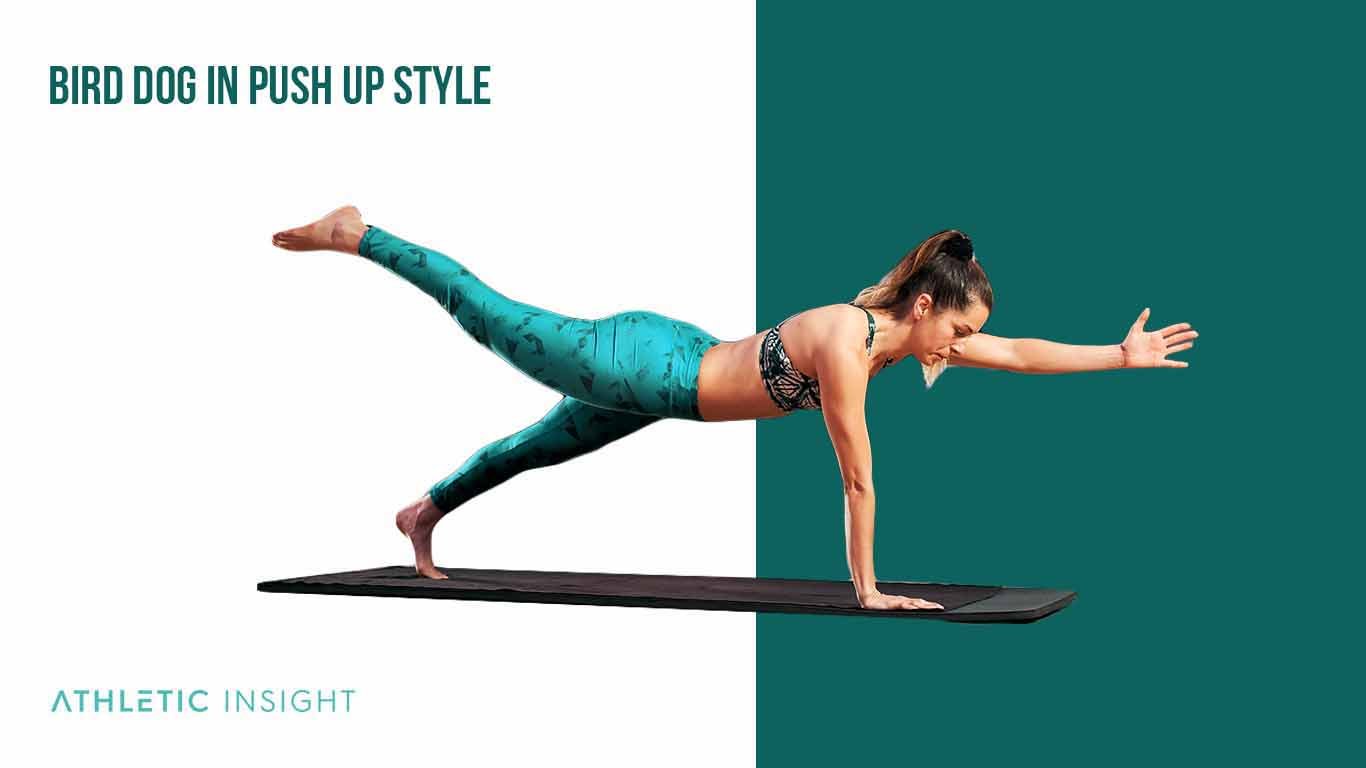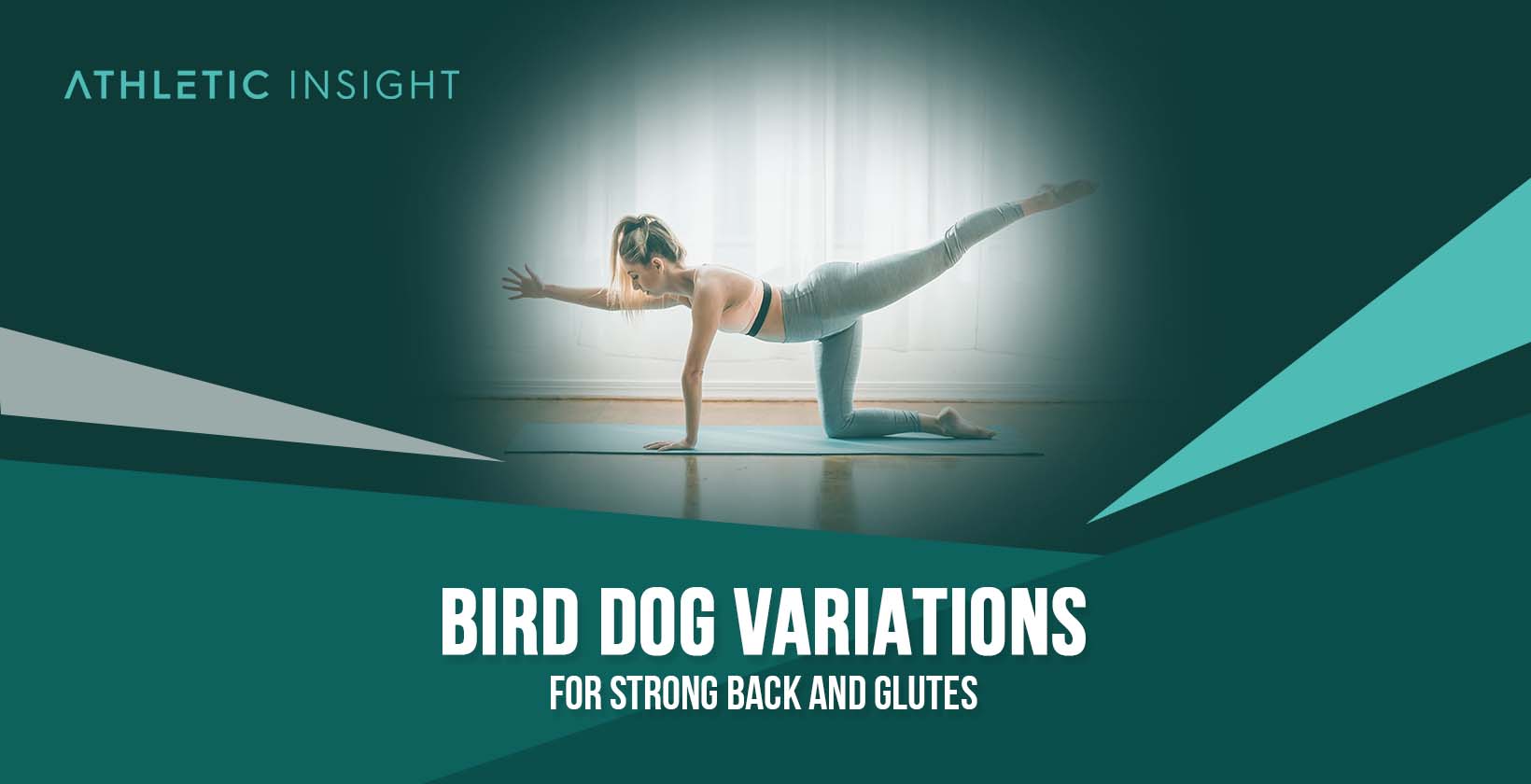The Bird Dog exercise and its many variations consist of an individual placing their hands and knees on the floor while extending one arm or an arm and leg at a time. This extension helps to engage the core muscles, the rectus abdominis, strengthen the back muscles, the erector spinae, and tone the buttocks, including the gluteal muscles.
Although the standard Bird Dog movement is worthwhile to see results, some Bird Dog weight variation exercises can increase the intensity. Alternatively, other Bird Dog variations can help make the training easier for someone recovering from an injury or has mobility issues.
The traditional Bird Dog movement falls under the classification of a bodyweight exercise, helping to improve flexibility and functional training. In addition, there are weighted variations that athletes can incorporate to produce a more intense challenge.
All Bird Dog variations can be beneficial, depending on the athlete’s current fitness level. Using weight before building up endurance can increase the chances of injury, though. It is important to work up and build muscle and strength slowly, especially when performing an exercise that involves core muscles, like the rectus abdominis and the erector spinae.
There are seven main bird dog exercise variations.
- Twisted bird dog
- Basic bird dog
- Elbow to knee bird dog
- Head to knee bird dog
- Basic elevated bird dog
- Bird dog in pushup style
- Standing bird dog
1. Twisted Bird Dog
The Twisted Bird Dog is a bird dog variation for athletes to focus on the back muscles, including the erector spinae, and strengthen the core, including the rectus abdominis and the obliques on the sides of the torso.
Athletes of any fitness level can perform this exercise. However, individuals with back issues should be mindful of how much rotation they use. A variation of this movement can include having one knee bent and resting on the floor with the other leg extended. This position helps make the exercise easier for beginners as it does not engage the entire core at once.
A common mistake when performing this Twisted Bird Dog exercise variation is rotating too much, which can cause back strains.
To perform this movement correctly, ensure that the head aligns with the spine throughout the exercise and engage the rectus abdominis, the core, the entire time.
Twisted Bird Dog also has different variations. The most popular variation is the Twisted Bird Dog with weights, where the athlete includes a hand weight for the extended arm.
2. Basic Bird Dog
The Basic Bird Dog variation focuses on the core and back muscles, including the rectus abdoniminis, obliques, and erector spinae. It is the standard beginner movement that is common for many gym-goers. Depending on the variation and the leg extension, it may also work the upper leg muscles, the quadriceps, hamstrings, and the buttocks (the gluteal muscles).

One common mistake when performing the Basic Bird Dog is allowing the belly to drop to the floor and the lower back to sink. This position does not engage the core muscles and makes the exercise less effective while increasing the chances of back injury.
To perform this exercise correctly, keep the head in line with the spine and ensure the extended arm and leg remain level with the body rather than angling upward or downward.
The Basic Bird Dog has several different variations. These Bird Dog pose variations include using a bench or raising the feet to make it easier or more difficult.
- Basic Bird Dog with Bench: Balance one knee and the opposite arm on a weight bench lengthwise while performing the opposite arm and leg extension to add an element of balance stability to the movement.
- Close Base Bird Dog on Bench: Balance on a weight bench widthwise, so the hand and knee are close to each other while performing the exercise.
- Basic Bird Dog on Toes: Balance on the forefoot of one leg while keeping the other leg extended with an opposite arm, then switch legs and arms during each repetition.
3. Elbow to Knee Bird Dog
The Elbow to Knee Bird Dog is a Bird Dog variation that focuses on strengthening the core muscles, the rectus abdominis, the back muscles, the erector spinae, and the hip flexors without putting extensive pressure on the spine. As a result, it is a less intense exercise for beginners or athletes recovering from an injury.
The abdominal crunching movement provides an additional workout for the core muscle group, the rectus abdominis, and allows more fluid movements for a functional exercise.
One common mistake when performing the Elbow to Knee Bird Dog is hyperextending the arm and leg. By allowing the arm and an opposite leg to extend too high above the neutral spine, the lower back will bow down, increasing the chance of muscle strain or injury.
It is not difficult to perform the Elbow to Knee Bird Dog correctly when you keep these tips in mind. First, round the back during the crunching movement when touching the elbow to the knee, but ensure the spine remains neutral during extension. Then, hold the stretch for one to two seconds before performing the crunch again.
The Elbow to Knee Bird Dog has different variations. These variations include using an exercise band to increase the intensity or hand weights to build more strength. Athletes can also use an exercise ball or move to a Plank position for other varieties.
4. Head to Knee Bird Dog
The Head to Knee Bird Dog is a Bird Dog variation that focuses on the abdomen muscles, the rectus abdominus, and the buttocks, the gluteal muscles. This movement is not strenuous for beginners, but it does require the athlete to be conscious of proper spine alignment to avoid injury.
Connecting the head to the knee gives the exercise a more considerable range of motion, increasing flexibility and endurance. Beginners who want to build up to a Bird Dog variation with weights can benefit from using the Head to Knee variation after the Basic Bird Dog as a transition movement.
When performing the Head to Knee Bird Dog, one common mistake is bending the head while keeping a neutral spine. The spine should round during the crunching of this exercise. Individuals can cause neck strain if trying to touch the head to the knee without rounding the back.
This movement can be challenging for beginners and is more common for intermediate gym-goers. To perform the Head to Knee Bird Dog variation correctly, some individuals may want to grasp their lower leg or knee to help reach their head. However, remember not to force your body to extend too far beyond what is possible, or you risk pulling or straining muscles.
The Head to Knee Bird Dog has different variations. These variations are common for more experienced athletes as they increase the intensity of the movement.
- Tiger Tucks: This alternative is a Head to Knee Bird Dog variation that requires the extended leg to remain bent and move up to the ceiling rather than out behind the body.
- Standing Head to Knee Bird Dog: This Bird Dog exercise standing variation has the athlete standing on one foot while extending one arm out front before performing a head to knee touch.
5. Basic Elevated Bird Dog
The Basic Elevated Bird Dog is a Bird Dog variation with the gym-goer elevated on their toes in a plank position. This stance engages more core muscles in the rectus obdominis, and back muscle strength, in the erector spinae while building stability and endurance.
This alternative exercise can be a natural progression for beginners to more difficult variations from the Basic Bird Dog exercise. In addition, because the stance extends from the shoulders and hips to the wrists and ankles, it lengthens the area of muscle engagement.
One common mistake when performing the Basic Elevated Bird Dog is allowing the spine to fall out of its neutral positioning. Therefore, the head, shoulders, and hips must remain in line to avoid injury and maximize the exercise benefits.
To perform the Basic Elevated Bird Dog variation correctly, ensure that the hands and wrists remain directly under the shoulders. In addition, extend the feet extend back behind the torso while remaining hip-width apart. This posture will also help maintain better balance during the movement.
The Basic Elevated Bird Dog has different variations. These variations include using hand weights or extra movement, such as an elbow to knee or head to a knee for additional focus in these Bird Dog exercise
6. Bird Dog in Push Up Style
The Bird Dog in Push-Up Style is a Bird Dog variation that focuses on the back muscles, erector spinae, buttocks, and gluteal muscles. It is also beneficial for individuals who perform yoga as it can help build up endurance and stamina for other yoga poses.

Athletes will perform a push-up at the bottom of this movement, increasing the intensity and focusing on the tricep muscles at the back of the upper arm and the pectoralis muscles in the chest.
This alternative is challenging and is mainly for intermediate or gym-goers who have increased strength and want to build intensity.
One common mistake when performing the Bird Dog in Push-Up Style is not using a full range of motion at the bottom of the movement. By shortening the push-up, this exercise is less effective at targeting the tricep and chest muscles.
To perform the Bird Dog in Push-Up Style, begin this exercise in a high plank position. Keep the head and neck in line with the spine as the leg, and opposite arm extend. The hands should be directly under the shoulders, and the legs should be shoulder-width apart for optimal balance.
The Bird Dog in Push-Up Style has several different variations. These variations can include adding intensity with weight or alternative positioning.
Keeping the extended leg raised out while performing the push-up at the bottom of the movement will give the targeted areas constant tension and provide quicker results. In addition, using a hand weight can increase muscle strength and endurance to aid in performing other Bird Dog yoga variations easier.
7. Standing Bird Dog
Standing Bird Dog is a Bird Dog variation that focuses on proper posture, balance, and flexibility while activating the core muscles, the rectus abdominis, the back muscles, the erector spinae, and the upper legs, including the gluteal muscles, hamstrings, and quadriceps.
This alternative posture builds on stability and balance while targeting the same muscle groups from the Basic Bird Dog movement. Although beginners can include this movement into a routine, it can be challenging while remain stable on one foot for the exercise.
Yoga enthusiasts will often gravitate to this Bird Dog Plank variation to enhance balance, coordination, and flexibility. However, one common mistake when performing the Standing Bird Dog movement is rotating the hips and pelvis as you lean forward. Ensure that the hips stay level so the pelvis does not rotate, which can create strain on your hip flexors.
To perform the Standing Bird Dog effectively, maintain an active core by engaging the rectus abdominis muscles through the entire movement. This action will also help keep the back straight so avoid any rounding of the shoulders and back.
The Standing Bird Dog exercise has several variations for individuals of all fitness levels. Some variations include using hand weights, building up strength, or holding the position for an extended period, for increasing endurance.
What to Know About Bird Dog Variations
Facts about Bird Dog alternatives are listed below.
- Muscle Growth: Bird Dog alternatives can enhance a workout routine by targeting specific muscle groups better than the Basic Bird Dog, such as the Bird Dog in Push Up Style, which also activates the shoulders and chest muscles.
- Endurance: Variations of the Bird Dog exercise can help athletes improve muscle endurance, such as the Twisted Bird Dog, which activates the oblique muscles and builds more core and back strength.
What Are the Common Mistakes in Doing the Bird Dog Variations?
Common mistakes when doing yoga Bird Dog variations are over-extending the arms and legs, over-rotating the upper body, and not keeping the head and neck in line with the spine.
- Over-extending the arms and legs: An extension of the arms and legs that goes beyond what is safe may lead to muscle tears and joint pain.
- Over-rotating the upper body: An over-rotation of the upper body may cause tearing of muscle ligaments, back pain, and permanent spinal damage.
- Not keeping the head and neck in line with the spine: To prevent muscle strains, vertebrae damage, and permanent loss of limb functioning within the body, it is important to maintain a neutral spine.
All of these mistakes can invite injury and make the exercise less effective.
What Type of Bird Dog Variation is Beginner-Friendly?
The Basic Bird Dog variation and the Basic Elevated Bird Dog exercise are beginner-friendly movements that beginners can complete while building strength and endurance. Bird Dog exercises can be challenging movements. Thankfully, many variations are beginner-friendly.
Which Type of Bird Dog Variation is Good for Weightlifters?
Head to Knee Bird Dog is suitable for weightlifters because it targets areas of their bodies like the glutes, core, and legs. Over time, this variation can help weightlifters bulk up and lift more muscle.
Which Type of Bird Dog Variation is Good for Athletes?
The Standing Bird Dog variation is suitable for athletes since it encourages more total-body movement and activation.
Which Type of Bird Dog Variation is Good for Bodybuilders?
As with weightlifters, head to knee bird dog is excellent for bodybuilders because it helps them develop their core muscles and glutes. This bodybuilding exercise is also good for toning the legs.
Which Bird Dog Variation is More Difficult than a Regular Bird Dog?
Several Bird Dog variations on this list are more complicated than regular movements. For example, Standing Bird Dogs and Bird Dog Push Ups tend to be much more difficult because they require core strength and flexibility. The Head to Knee Bird Dog variation is also quite challenging.
Which Bird Dog Type Exercises the Abs More?
Every bird dog variation type targets the abdominal muscles equally. If you would like to add these ab workouts to your routine and are looking for the one that’ll grow your abs the most, the solution is to use more resistance while performing any of these. This can be done using bands or weights.
Which Bird Dog Type Exercises the Back More?
Basic Elevated Bird Dog is one of the best variations that focus on the back muscles.
Do Bird Dog Variations Act on Different Muscles
Some Bird Dog variations target other areas, such as the erector spinae in the back. Head to Knee variations strengthens the gluteal muscles. Any Standing Bird Dog variation pose can help balance and flexibility.
What are the benefits of the Bird Dog?
The Bird Dog offers many benefits, including improved core strength, balance, coordination, posture, glute and hamstring activation, shoulder stability, and body awareness. While the bird dog is beginner friendly, this simple exercise should not be overlooked.
What Are the Alternatives of Bird Dog Exercises?
Although making Bird Dog poses and variations can be a valuable part of an exercise routine, there are a few other poses and Bird Dog alternatives to try for similar benefits.
- Yoga bridges
- Bicycle crunches
- Planks
- Flutter kicks



